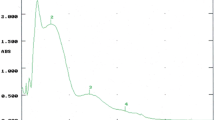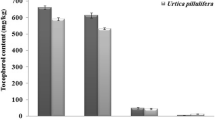Abstract
In this study, fatty acids, phytosterol classes and tocopherols composition of Milk thistle seeds oil were determined at four varieties grown in Ardebil-Iran. The four varieties consisted of two modified foreign varieties—Budakalaszi (originally from Hungary) and the CN-seed variety (originally from England) and two native varieties, namely Khoreslo and Babak Castle. The oil content of the seeds ranged from 26 to 31%. Among the fatty acids, linoleic acid had the highest percentage (50–54%) followed by oleic acid (23–29%) and palmitic acid (7–8%). This is the first detailed report on the phytosterol classes of milk thistle seeds oil. The 4-Desmethylsterol class was predominant (1,800–2,200 μg/g) followed by 4,4′-dimethylsterols (50–85 μg/g) and 4-monomethylsterols (26–35 μg/g). The α-, β-, γ-, and δ-tocopherols ranged from 187 to 465, 10 to 51, 9 to 12, and 18 to 80 μg/g oil, respectively. Based on the results obtained, the extracted oil from milk thistle seeds are rich in essential fatty acids, sterols and vitamin E and can be an attractive candidate for use in food preparation mixed with other vegetable oils or alone.


Similar content being viewed by others
References
Hadolin M, Skerget M, Knez Z, Bauman D (2001) High pressure extraction of vitamin E-rich oil from Silybum marianum. Food Chem 74:355–364
Angeles SM, Fernandez-Tarrago J, Purificacion C (2005) Yeast extract and methyl jasmonate-induced silymarin production in cell cultures of Silybum marianum (L.) Gaertner. J Biotechnol 119:60–69
Ramasamy K, Agarwal R (2008) Multitargeted therapy of cancer by silymarin, Cancer letters 269:354–362
Khan SA, Khan KH, Zak AS, Waheed I, Raie MY, Bhatty MK (1985) Fatty acids from indigenous resources for possible industrial applications. VIII. Investigations of some species of Compositae family. Pak J Sci Ind Res 28:400–402
Vojtisek B, Hronova B, Hamrik J, Jankova B (1991) Milk thistle (Silybum marianum) in feed given to ketonic cows. Vet Med 36:31–33
El-Mallah MH, El-Shami SM, Hassanein MM (2003) Detailed studies on some lipids of Silybum marianum (L.) seed oil. Grasas-y-Aceites 54:397–402
Azadmard-Damirchi S, Savage GP, Dutta PC (2005) Sterol fractions in hazelnut and virgin olive oils and 4, 40-dimethylsterols as possible markers for detection of adulteration of virgin olive oil. J Am Oil Chem Soc 82:717–725
Savage GP, Mcneil DL, Dutta PC (1997) Lipid composition and oxidative stability of oils in hazelnuts (Corylus avellana L.) grown in New Zealand. J Am Oil Chem Soc 74:755–759
Azadmard-Damirchi S, Dutta PC (2006) Novel solid-phase extraction method to separate 4-desmethyl-, 4-monomethyl-, and 4, 4′-dimethylsterols in vegetable oils. J Chromatogr A 1108:183–187
Azadmard-Damirchi S, Dutta PC (2008) Stability of minor lipid components with emphasis on phytosterols during chemical interesterification of a blend of refined olive oil and palm stearin. J Am Oil Chem Soc 85:13–21
Yehuda S (2001) PUFA: mediators for the nervous, endocrine, immune systems. In: Mostofsky DI, Yehuda S, Salem N (eds) Fatty acids: physiological and behavioral functions. Humana, Totowa, pp 403–420
Parry J, Hao Z, Luther M, Su L (2006) Characterization of cold-pressed onion, parsley, cardamom, mullein, roasted pumpkin, and milk thistle seed oils. J Am Oil Chem Soc 83:847–854
Gunstone FD (2000) Composition and properties of edible oils. In: Hamm W, Hamilton RJ (eds) Edible oil processing. Sheffield Academic Press, Sheffield, England, pp 1–33
Moreau RA (2004) Plant sterols in functional foods. In: Dutta PC (ed) Phytosterols as functional food components and nutraceuticals. Marcel Dekker, New York, pp 317–346
Przybylski R, Eskin N (2006) Minor components and the stability of vegetable oils. Inform 17:186–188
Deraz S, Bayram E (1995) Evaluation of chemical contents of medicinal plant (Silybum marianum (L.) Gaertner) wild growing in Turkey. Ege-Ueniversitesi-Ziraat-Fakueltesi-Dergisi 32:79–85
Kamal-Eldin A, Appelqvist LA (1996) The chemistry and antioxidant properties of tocopherols and tocotrienols. Lipids 31:671–701
Burton GW, Traber MG (1990) Vitamin E: antioxidant activity, biokinetics, and bioavailability. Annu Rev Nutr 10:357–382
Burton GW (1994) Vitamin E: molecular and biological function. Proc Nutr Soc 53:251–262
Author information
Authors and Affiliations
Corresponding author
About this article
Cite this article
Fathi-Achachlouei, B., Azadmard-Damirchi, S. Milk Thistle Seed Oil Constituents from Different Varieties Grown in Iran. J Am Oil Chem Soc 86, 643–649 (2009). https://doi.org/10.1007/s11746-009-1399-y
Received:
Revised:
Accepted:
Published:
Issue Date:
DOI: https://doi.org/10.1007/s11746-009-1399-y




